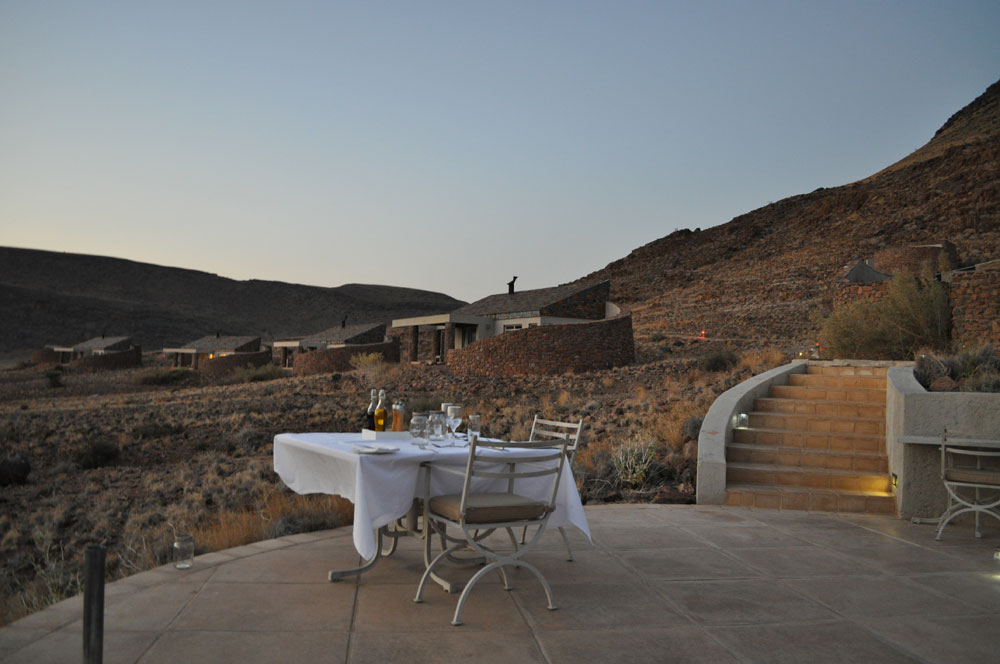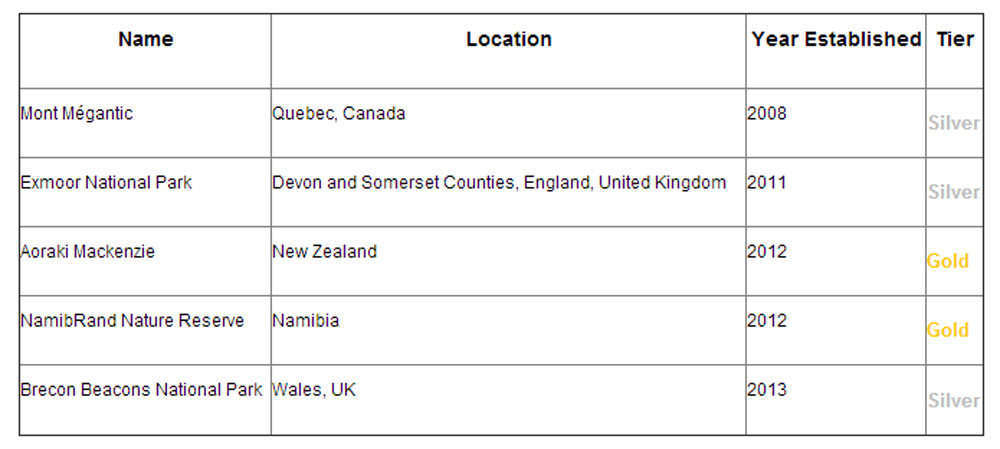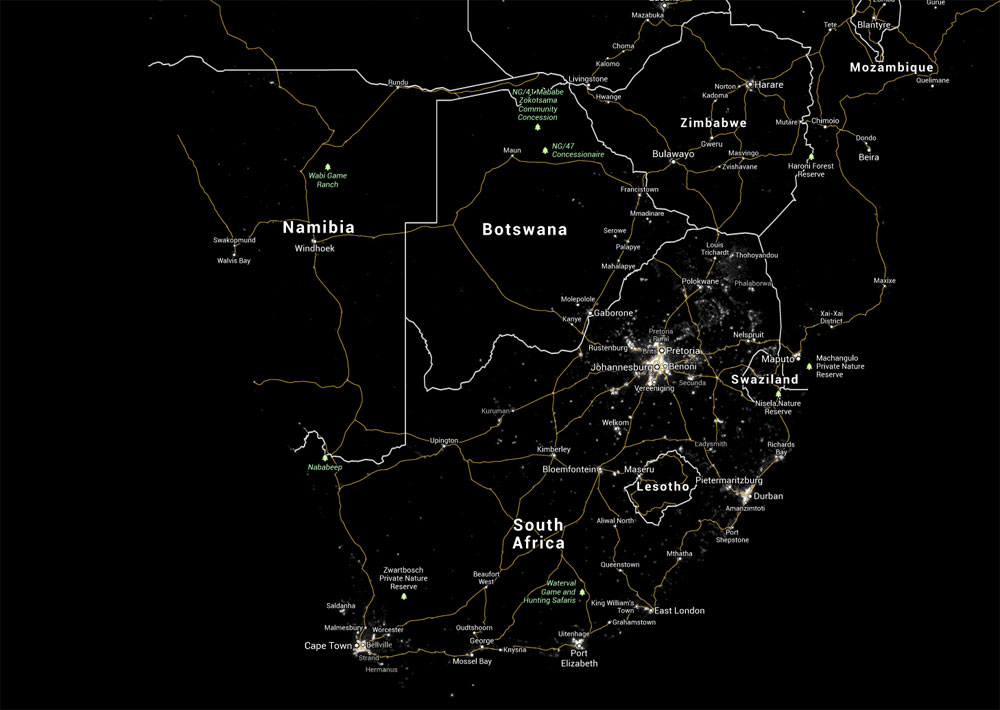In late September / early October 2011 I travelled round Namibia on a two-week tour which culminated in a 4-night stay in the & Beyond property, the Sossusvlei Desert Lodge which is located in the largest private nature reserve in Southern Africa, the NamibRand Nature Reserve at some 180,000 hectares (445,000 acres). The primary appeal of the venue was the promise of pristine dark skies (listed #1 in the 2009 Conde Nast Traveller UK of the 6 best places in the world to go stargazing) combined with an onsite astronomer and telescope for use by guests. The skies did not disappoint, though my visit coincided with a moon between First Quarter and Waxing Gibbous so the observing of all the Southern Hemisphere Deep Sky Gems did not begin in earnest till the early hours of the morning.
When decision time for a late summer 2013 holiday arrived, Africa was once again chosen as the venue, with Botswana and Zambia being the primary destinations I saw this as an opportunity to once again visit the venue which gave me my first taste of Southern Hemisphere stargazing. This time however, we specifically planned to arrive on the day of New Moon (October 5th 2013) and stay for 4 nights.
The Sossusvlei Desert Lodge:
The Sossusvlei Desert Lodge is nestled against ancient mountains and looks out on to long plains that rise towards distant dunes of orange, sienna and pumpkin on the horizon. The lodge itself consists of 10 guest villas (meaning no more than 20 visitors at any one time) spread out on a curve, constructed of natural local materials including bone, slate and stone combined with floor to ceiling windows allowing the view to continue outwards without interruption. Each villa benefits from a large skylight above the bed allowing you to count the stars as you slowly drift off to sleep.
The main communal building is constructed in a similar style and provides dining, relaxation areas, a veranda and a swimming pool which is fed by an underground spring. A waterhole set a couple of hundred yards in front of the main building means there is always plenty of local wildlife on show including oryx, zebra and springbok. The observatory is set back from the main building slightly up the hill.
Needless to say the landscapes on offer, including plains, mountains and petrified dunes are stunning, but the highlight must be the ever evolving and twisting sand dunes which are among the tallest in the world and reach up 750 ft high.
Daytime activities include visits to the sand dunes and petrified dunes (a wonderful place to enjoy a sundowner while the sky transforms from blue to almost infinite hues of red and orange, as well as game drives where giraffe and leopards may be spotted among numerous other local species, balloon flights and guided nature walks. For the more adventurous, quad biking, and hikes to see the San Rock paintings are available. For any birdwatchers, there are over 100 native bird species in the region.
An International Dark Sky Reserve:
Since my visit in 2011, the NamibRand Nature Reserve had applied to the IDA, the International Dark Sky Association (www.darksky.org), for International Dark Sky Reserve status and was designated with the highest Gold Tier award in 2012.
Three tiers designate the quality of the night skies the reserve is recognised for. Gold represents the highest award for dark skies, followed by silver and bronze designations. Requirements for each of the designations are shown in the table below.
To date only 5 international Dark Sky Reserves have been certified, including 2 sites in the UK.
Further details about International Dark Sky Reserves can be found at DarkSky.org.
The light pollution map below (find more maps at Blue-Marble.de) clearly shows what an advantage Namibia has for dark skies. The capital city Windhoek is approximately 300km away as the crow flies, and the Desert Lodge itself is some 95km from neighbouring communities, all of which are small.
Equipment Available:
The telescope available at the Desert Lodge is a 12” (305mm) Meade LX200R f/10 (3,048mm focal length) fork mounted scope configured in Alt Az with a range of eyepieces. The “R” denotes Ritchy-Chretian “Type” optics though due to competitor pressure this was later changed to ACF (Advanced Coma Free). This was just a name change, the optics are the same. The scope comes complete with the Autostar II controller with 145,000 object database.
The observatory has a number of eyepieces available for use in a variety of focal lengths including plossls and wider field designs. The visiting astronomer during my visit had also brought along an EP from his personal collection, the Televue Ethos 17mm (100 degree apparent field) which is remarkable and well worth the investment. This made me realise that it was rather foolish that I did not bring one or two of my own, but honestly, any serious observer would be well served by what is already available.
Meeting the Resident Astronomer:
The lodge has a number of resident astronomers many of whom stay for up 2 months at a time to share the wonders of the night sky with guests. Most are either retired astronomers or on sabbatical and all are very knowledgeable and passionate about astronomy. During my latest stay, the resident astronomer was Doug McCarty, a retired planetarium director, and a member of the Science Integration Institute.
On our first late afternoon activity, a visit to the petrified dunes, Doug happened to join us, and this gave me a fantastic opportunity to introduce myself and my hopes for the next four nights. We ended up chatting astronomy for almost the entire duration of the trip. His enthusiasm for all things astronomy clearly matched my own, as was his willingness for dusk till dawn observing sessions. I could not wait for darkness to arrive.
First Night – Showpieces and an Early Finish:
For any Northern Hemisphere based observer, one object normally springs immediately to mind when thinking of Southern Hemisphere gems we wish we had in our skies, and that DSO is Omega Centauri (NGC 5139 / Caldwell 80). The largest of all Milky Way GCs, the cluster spans some 280 light years, containing several million stars and mass of approximately 5 million solar masses, which would make it as much as 10x the size of other large globular clusters and a rival to some dwarf galaxies. Under dark skies, Omega Centauri is visible as a magnitude 3.5-4 fuzz even with direct vision. Due to setting shortly after 8pm during our visit, this object was the reason to visit the observatory before dinner. For all the stunning statistics though, I find this GC far less interesting than some others. Despite its size (as much as 30’ or more visually, which is the size of the full moon, and as much as 55’ photographically) I find it presents far less interesting structure and complexity when compared to other GCs, showing little increase in density from outer regions to the core. However, that being said, in the 32mm plossl at 95x and a 0.52 degree FoV, seeing a GC fill the field is quite a view!
Eating dinner perhaps a little too quickly, I was back up at the observatory a mere hour later ready to take in more celestial sights. The whole Scorpius / Sagittarius region is never well placed for viewing from the UK, so I was not going to pass up the chance to view all the interesting showpiece objects towards the galactic centre. We started with M6, the Open Cluster (OC) known as the Butterfly Cluster which showed its distinctive butterfly shape among its hundreds of stars and 20’ dimensions in the 32mm plossl. From there we moved barely a degree to M7, another OC known as Ptolemy’s Cluster. Visible as a distinct brightening in the Milky Way star clouds, the cluster at 80’ exceeded any field we could achieve with the 12” scope, meaning the view just exploded with stars, and made me wish I had one of my small wide field scopes with me, which are made for DSOs such as this. What struck me as interesting is that the cluster is surrounded by the ethereal light of the Milky Way as we panned around it, which stands in contrast with nearby M6 which sits outside the Sagittarius star clouds.
We then moved on to four emission nebula in Sagittarius, M8, M16, M17 and M20. The Lagoon nebula (M8) spans over a degree in the long dimension so it pays to pan around to take in the whole view. The nebula is particular interesting on the eastern side due to the OC, NGC 6530, made up of some 100 stars which the nebula envelopes and swirls around. M20, the Trifid Nebula has always been one of my favourite DSOs, and the view in a now jet back sky did not disappoint. The dark lanes bisecting the emission nebula that give it the Trifid name were striking, and the reflection nebula was also clearly visible.
After taking in a number of OCs and GCs in the region (it really is a very busy patch of sky), we decided to move on to two of the Southern Hemisphere true gems, the Tarantula Nebula (NGC 2070 / C 103) in Dorodo, and in my opinion, the greatest globular in the sky, 47 Tucanae (NGC 104 / C 106).
Starting with 47 Tucanae, which sits close to the Small Magellanic (both the SMC and LMC are impossible to miss in these skies as extended nebulous patches of light), you cannot fail to be blown away by this cluster the moment it moves into view. Intrinsically, this GC has one of the greatest masses in the Milky Way, containing millions of stars; its apparent magnitude sits only behind Omega Centauri in total brightness and it is also one of the closest GCs to the Sun. In the 32mm plossl, the cluster fills a good portion of the field and the brightness is immense. It is 3x brighter than the M22, the brightest Messier Globular. John Herschel described the cluster as “excessively compressed” and that was the first and most obvious component I noticed. The increase in star density towards the core makes it seem like someone has turned on a torch and shinning straight down the telescope at the centre. Taking some time to observe 47 Tucanae, to me it appeared as though some “spindle arms of stars” were extending from the core. If this GC sat in the northern hemisphere, I do not think M13 would be known as the “Great” Globular Cluster in Hercules.
Probably my favourite DSO anywhere in the sky, I first viewed the Tarantula Nebula in Namibia in 2011 and I could not wait to be reacquainted with this beautiful object. I was truly blown away in 2011, even more so when one considers what is actually being observed. Located in the Large Magellanic Cloud at some 165,000 light years away (and visible to the naked eye as a brightening on the eastern side of the LMC, it is the most massive star forming region known in the local group with a diameter of approximately 600 LY (the Orion Nebula, M42 has a diameter estimated at 24 LY). In fact this object is so large and bright, that were in located at the distance of M42 (~1,300 LY), it would extend beyond the entire constellation of Orion and cash shadows on Earth! The Tarantula was also the location of Supernova 1987A which occurred on the outskirts of the nebula and is to date, the closest supernova since the invention of the telescope.
At the heart of the nebula is a compact but massive cluster of hot young stars that generate most of the energy which makes the nebula visible. Hundreds of stars within this cluster are visible in the scope but for me, the nebula itself is the real draw. I would argue that the visual appearance of all the loops and tendrils closely matches what is revealed in long exposure photographs. To me it seems like we are viewing the spider from the underside and it is reaching out towards the viewer through the eyepiece. I always think it is worth reminding yourself that you are seeing an object in another galaxy when viewing the Tarantula. It makes it even more remarkable in my mind.
Dragging myself away from the Tarantula, we moved on to some more showpiece objects including galaxies, planetary nebula and more globular clusters. The final object of a truncated nights observing was NGC 55, a barred spiral galaxy in Sculptor. A stunning edge on barred spiral, it appears long and thin. The nucleus and dark lanes become more visible the longer you spend with the galaxy (averted vision not needed with a 12” scope on this one!) and there is a great deal of structure and mottling to be seen within the galaxy and it seems like there are plenty of “faint fuzzies” and stars on the limit of perceptibility.
“Unfortunately” there was to be a 5.15am wake up call for an excursion to the largest sand dunes in the world. This in itself would not have been a problem, but it is approximately a 6-hour round trip so having no sleep until at least midday meant we called it a night just after half past midnight. As I walked away from the observatory back to my villa, I was buzzing with excitement and anticipation of the next nights stargazing. Truth be told, I slept very little that night, continuing to stargaze through the wonderful skylight positioned above the bed.
On to Night two.












Pingback: Stargazing under fantastically dark Namibian Skies – Night 2 | Alpha Lyrae
Pingback: New Astro-Tourism Project planned for Lake Tekapo | Alpha Lyrae
Pingback: Third night observing in Africa’s 1st IDA Dark Sky Reserve | Alpha Lyrae
Pingback: Prettiest Colour Contrasted Double Stars | Alpha Lyrae
Pingback: How many of you can see the Milky Way at night? Part II - Page 9
Pingback: Wide Field Astrophotography in Namibia | Alpha Lyrae
Pingback: Stargazing in Mozambique | Alpha Lyrae